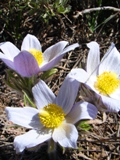Wildlife
 Over
200 species of migratory and resident birds are known for this area including
the raven, mountain bluebird, gray jay, yellow warbler, goshawk, osprey and
waterfowl and shorebirds attracted to the reservoir. Mule deer and elk are a
common sight, as are cottontail rabbit, jackrabbit, beaver, red fox, coyote,
badger, ground squirrel and muskrat. Many anglers are attracted by the
cold-water fishing opportunities which feature rainbow, brook, German brown and
cutthroat trout. Mountain whitefish, white sucker and sculpin are also
present.
Over
200 species of migratory and resident birds are known for this area including
the raven, mountain bluebird, gray jay, yellow warbler, goshawk, osprey and
waterfowl and shorebirds attracted to the reservoir. Mule deer and elk are a
common sight, as are cottontail rabbit, jackrabbit, beaver, red fox, coyote,
badger, ground squirrel and muskrat. Many anglers are attracted by the
cold-water fishing opportunities which feature rainbow, brook, German brown and
cutthroat trout. Mountain whitefish, white sucker and sculpin are also
present.
Plants
 Ecologically, park uplands are dominated
by montane shrub communities comprised of mountain big sagebrush, mountain
snowberry, serviceberry, Gambel oak, antelope bitterbrush,
chokecherry and rabbitbrush. Common understory plants include wild buckwheat,
American vetch, lupine, aspen peavine and Hood’s phlox. Above the park,
lodgepole pine, subalpine fir, Colorado blue spruce and aspen are the dominant
forest trees. Diverse wetland and riparian plant communities have become
established around the reservoir, along the Yampa River and its tributary
drainages. A large wetland creation project has been constructed along the
river, providing interpretive opportunities.
Ecologically, park uplands are dominated
by montane shrub communities comprised of mountain big sagebrush, mountain
snowberry, serviceberry, Gambel oak, antelope bitterbrush,
chokecherry and rabbitbrush. Common understory plants include wild buckwheat,
American vetch, lupine, aspen peavine and Hood’s phlox. Above the park,
lodgepole pine, subalpine fir, Colorado blue spruce and aspen are the dominant
forest trees. Diverse wetland and riparian plant communities have become
established around the reservoir, along the Yampa River and its tributary
drainages. A large wetland creation project has been constructed along the
river, providing interpretive opportunities.
Geology
Stagecoach State Park features a 780
surface-acre reservoir lying in the Yampa River Valley of the northern Rocky
Mountains. It is fed by the Yampa River and Little Morrison, Middle, Taylor and
Martin creeks. The park is situated on the western flank of the Park Mountain
Range and the southeastern flank of the Washakie Sedimentary Basin, thus
positioned between Precambrian granitic and Tertiary sedimentary rocks. Tertiary
Age Brown's Park Sandstone, sedimentary rock with silicic ash beds and some
conglomerate, outcrops throughout the park. Precambrian gneiss represents the
common rock at the damsite. Pleistocene Crowner Formation volcanic,
conglomeritic sandstone and Pleistocene alluvium occupies the reservoir
shoreline.

